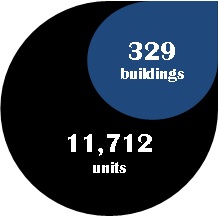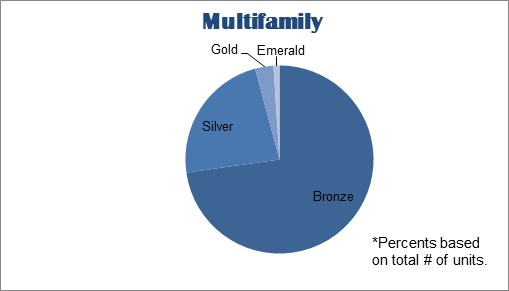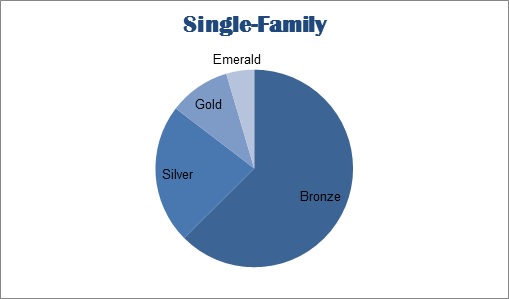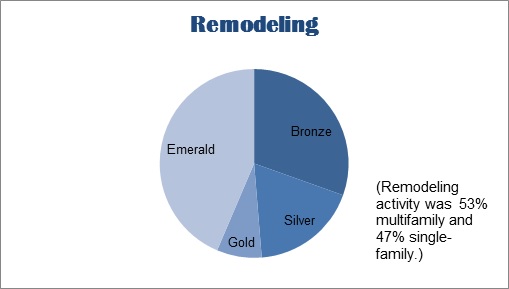Cindy Wasser, MBA
January 9, 2014
5 Green Home Building Trends from 2013
This past year was a big year for Home Innovation’s NGBS Green Building programs, both in terms of new developments/changes and program growth. If you haven't already, I'd encourage your to take a look back at Michelle Desiderio’s Green Building Odyssey post from last April that described numerous program developments from just the first quarter of 2013.
Here are a few notable certification trends we saw last year:
1. Total Certification Activity Was Up
If you look at just home/building certifications, it would seem that green building activity diminished slightly in 2013. However, the real story lies in the unit (or home/apartment) count. The multifamily housing market was booming throughout 2013, and Home Innovation certified nearly twice the number of living units/apartments we did 2012.

2. Multifamily Certifications Remain Largest Market Share
Multifamily (new construction) certifications comprised about 15% of all our green home/building certifications, but nearly 82% of our total unit count.

There are a few reasons why I believe multifamily developers are leading the industry in green certified homes.
- Project Costs. With a proportionally larger construction budget, multifamily developers can incorporate green construction practices more easily than single-family builders. The additional cost of incorporating green practices/products is easier to manage when it’s spread across multiple units.
- Lower Operating Expenses. Many apartment owners are directly involved in both construction and the long-term management of the company’s portfolio. As such, the companies have a clear financial incentive to integrate green building practices that lower operating costs long-term.
- Consumer Demands. Today’s renters are young, urbane, and notably interested in a more sustainable lifestyle.
3. Single-Family and Remodeling Certifications More Likely to Achieve Higher Levels
While the multifamily sector has experienced the greatest volume of certification, single-family homes and renovation/remodels are more likely to achieve higher levels (Silver, Gold, Emerald).
Multifamily developers assess the value of green certification in terms of ROI. Developers select a green certification level and practices based on the local construction code (incentives or mandates for green development) and the expected savings from energy and water efficiency. Many are comfortable building to the Bronze level (which is still a notably rigorous mark!).

There are a number of single-family homebuyers who are willing to spend more to achieve higher levels of green. In particular, custom homebuilders have certified a number of highly-efficient green homes with unique features that were integrated based on client needs. Check out these examples from Treasure Homes, Inc., and Caldwell & Johnson.

Older homes are notoriously inefficient. Remodels/renovations to achieve significant energy and water efficiency gains are usually much easier than attaining the same efficiencies with new building codes.

4. North Carolina Still Leads Nation in Volume
North Carolina continues to lead the nation in terms of volume, as green building activity is strong throughout the Triangle and Charlotte metro areas. There are several reasons for the high-volume activity in the state.
- Green Building Champions. Green-minded HBA leaders, third-party professionals, and builders/developers are working to make green certified homes mainstream — many who have made particularly notable contributions are in the Raleigh/Durham area.
- Covenant Restrictions in Some Communities. Some N.C. developers are stipulating green certification in the land development agreement. All homes built within those communities will be green certified to the NGBS or another program.
- Local Incentives. Catawba (Charlotte metro area) and Chatham County (Raleigh metro area) offer permit fee rebates to builders certifying to the NGBS.
NGBS certification has good penetration throughout the East Coast and Midwest. States like Maryland, New York, and Delaware experienced strong certification activity due to
local/state government incentives.
5. Continued Growth for 2014
Given the total number of NGBS Green Registered units in process, Home Innovation is positioned to more than double the number of certifications we will issue in 2014 and 2015. We believe that builders have recognized NGBS Green certification offers an affordable, streamlined, and yet rigorous path to independent, third-party green certification.

So what green home building trends did you see over the last year? What are you predicting for the coming year? Let me know.
Back to Top